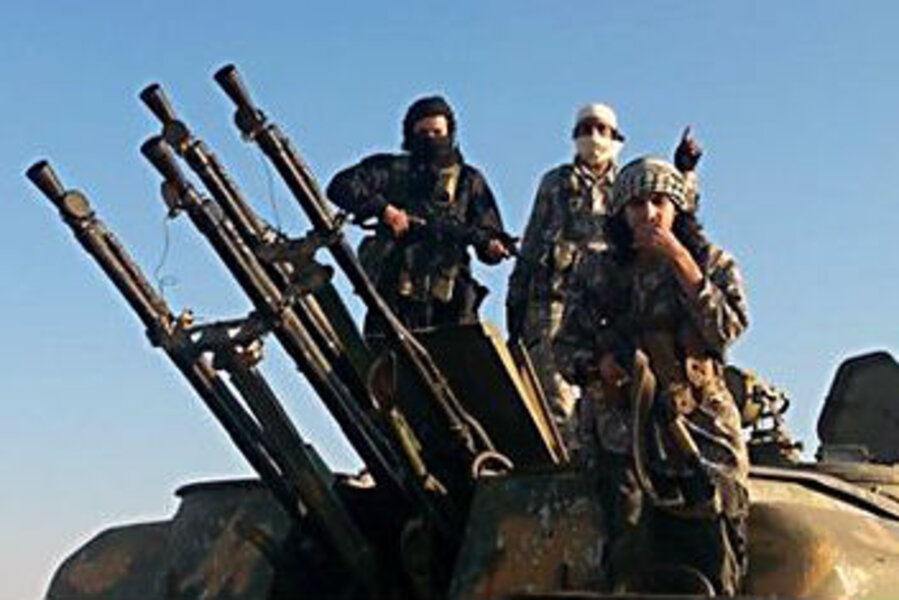Why the FAA banned US airline flights over Syria
Loading...
| Washington
Armed groups in Syria have an estimated several hundred portable anti-aircraft missiles that could easily be diverted to extremists and used to destroy low-flying commercial planes, according to a new report by a respected international research group. It cites the risk that the missiles could be smuggled out of Syria by terrorists.
The report was released just hours after the Federal Aviation Administration issued a notice Monday to U.S. airlines banning all flights in Syrian airspace. The agency said armed extremists in Syria are "known to be equipped with a variety of anti-aircraft weapons which have the capability to threaten civilian aircraft."
The agency had previously warned against flights over Syria, but had not prohibited them.
Small Arms Survey, a Switzerland-based research organization that analyzes the global flow of weapons, published its findings Tuesday following last month's lethal missile attack on a passenger jet flying over Ukraine. The report focuses on launchers and missiles known as "man-portable air defense systems," or MANPADS, which are dangerous to planes flying at lower altitudes or ones taking off or landing.
The new report estimated that several hundred anti-aircraft missile systems are already in rebel arsenals. Mostly Russian and Chinese in origin, the weapons have been seized by Syrian opposition militias from government forces and smuggled in from nations sympathetic to the insurgents, the report said.
The most immediate danger is that anti-aircraft weapons, especially newer and sophisticated models, could easily be diverted to extremist groups operating outside Syria, it said. Porous borders and the presence in Iraq and other neighboring countries of groups affiliated with Al Qaeda and other extremists heighten the danger that anti-aircraft weapons could spread to other trouble spots.
"In the hands of trained terrorists with global reach, even a few missiles pose a potentially catastrophic threat to commercial aviation," wrote Matthew Schroeder, the report's author. The analysis is based on government and media reports and video footage of anti-aircraft weapons posted online from inside Syria.
The extremist Islamic State group that has overrun much of northern and western Iraq also operates inside Syria. The militants, who have drawn fire from U.S. drones and fighter jets, recently posted an online propaganda video showing one fighter appearing to fire an older-model, Russian-made SA-7 missile system.
Most American and other commercial airlines already have halted flights over and into Syria during the past three years of conflict between the Assad government and insurgents. Citing the threat of MANPADS strikes, the FAA warned American carriers in May 2013 to avoid Syrian airspace, a move that was heightened Monday to a total ban.
"Opposition groups have successfully shot down Syrian military aircraft using these anti-aircraft weapon systems during the course of the conflict," the FAA said in its "notice to airmen." The agency added that the presence of anti-aircraft weapons creates a "continuing significant potential threat to civil aviation operating in Syrian airspace."
Russia earlier halted all of its civilian flights to Syria in April after officials in Moscow said a Russian charter plane flying from Egypt into Syrian air space was targeted by two surface-to-air missiles but escaped damage.
The destruction of Malaysia Airlines Flight MH17 last month was a clear signal that civilian aircraft could be exposed to anti-aircraft missiles at both high and low altitudes, Schroeder said. "The shoot-down on Flight MH15 underscores the important of reining in the black market trade in all anti-aircraft missiles," he said.
The Malaysian jet was struck at 33,000 feet, well beyond the range of portable anti-aircraft missiles, killing all 298 people on board. U.S. officials said the Boeing 777 jet was struck by a long-range surface-to-air missile fired by pro-Russian separatists inside eastern Ukraine. Russia has denied any role in the attack.
Unlike larger vehicle-mounted systems, compact shoulder-fired missiles and tube launchers are difficult to track once outside of government control, and easy to dismantle and hide.
Schroeder said eight different MANPADS models have turned up in Syria. At least two varieties, the Chinese-made FN-6 and the Russian SA-24 Grinch, are newer and more sophisticated models with longer ranges than older varieties — up to 20,000 feet altitude— and are harder to repel by aircraft electronic jamming systems. A third new model spotted inside Syria has yet to be identified, Schroeder said.
"Once these weapons are out of government control, they could end up anywhere," Schroeder said.
The report names Sudan, Qatar and Saudi Arabia as likely sources for MANPADS systems smuggled to insurgents inside Syria but cautions there still is no certainty about their origins. Rebel groups have also boasted of seizing anti-aircraft launchers and missiles from Syrian forces.
U.S. officials have estimated the Syrian government had amassed as many as 20,000 MANPADS units before the civil war erupted in 2011.
Copyright 2014 The Associated Press. All rights reserved. This material may not be published, broadcast, rewritten or redistributed.







